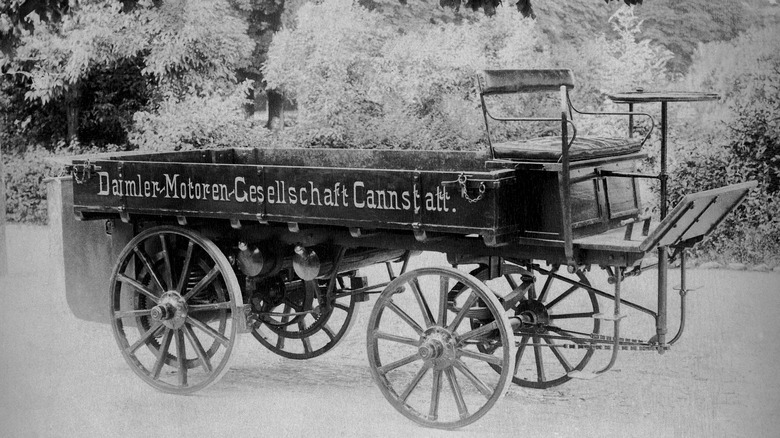The Person Who Invented The Motorcycle Also Made The First Pickup Truck
In 1885, German inventor Gottlieb Daimler built what's recognized as the world's first true motorcycle: the "Reitwagen," a wooden-framed two-wheeler powered by a single-cylinder internal combustion engine. But Daimler wasn't interested only in two wheels, and a decade later, in 1896, he adapted the same engine technology into something far more practical — the world's first truck.
Unlike today's pickups, it looked like a horse-drawn cart fitted with an engine instead of a drawbar. The two-cylinder "Phoenix" engine sat at the rear, producing about 4 horsepower and moving the vehicle on iron wheels. Daimler connected it to the rear axle by belt drive and cushioned it with springs to handle vibration. It was capable of hauling cargo at a time when animal power dominated. Daimler tested the truck at a brick factory to prove it could handle heavy work.
Daimler's early trucks quickly evolved from experimental machines into practical workhorses. In 1898, Daimler and Maybach moved the Phoenix two-cylinder engine from the rear to under the driver's seat, improving balance but leaving performance short. That same year, they advanced the design further by mounting the engine at the very front, ahead of the axle. This layout, combined with a four-gear belt drive and longitudinal shaft, set the foundation for modern trucks. Daimler also introduced Bosch's low-voltage magnetic ignition to replace hot tube ignition, paired with a redesigned radiator, marking a decisive leap in reliability and power output.
Daimler's first truck was tested at a brickworks
Gottlieb Daimler wanted proof his truck could handle real work before putting his name behind it. His five-ton prototype spent months at a brickworks in Heidenheim, running daily loads and revealing weaknesses that Daimler fixed one by one. What we'd now call customer testing was simply part of the process.
Once proven, the truck quickly drew international interest. The first buyer came from England, where steam wagons had long ruled local roads. By 1901, a Daimler truck outperformed a steam-driven rival in a comparison trial in Liverpool, underlining that internal combustion was the future. Daimler also brought the truck to Paris in 1898 for the World Exhibition. Crowds packed the Tuileries park to see his five-tonner and smaller four-horsepower model, a sign that commercial vehicles had as much draw as passenger cars.
In the U.S., Daimler partnered with Steinway & Sons to build engines and vehicles in New York. The Daimler Manufacturing Company operated until 1907, producing power plants for yachts as well as buses and trucks. Back in Germany, production expanded beyond Stuttgart. By 1899, Daimler trucks were being built in Berlin-Marienfelde, a facility that soon became DMG's commercial vehicle hub while Stuttgart factories focused on cars.
Between 1899 and 1905, Daimler's truck program grew from light vans to heavy haulers with payloads up to five tonnes. Engines ranged from two-cylinder eights to four-cylinder thirty-fives. Karl Benz followed with his own line in 1900, completing the foundation for the modern truck.
Ford popularized the pickup in America
While Daimler set the stage in Germany and went on to found Mercedes-Benz (one of the little-known facts about the company), the pickup as Americans know it started with Henry Ford. Farmers had already been modifying Model Ts to carry equipment, so Ford saw the demand and created the first factory-built pickup in 1925: the Ford Model T Runabout with Pickup Body. It came with a cargo bed and cost just $281, selling more than 30,000 units in its first year. The Model T was the first affordable pickup made at scale.
That distinction made it the backbone of rural America, turning workhorse trucks into an everyday tool. Later models like the Dodge Power Wagon and Willys Jeep expanded the market beyond farms, introducing four-wheel drive and utility that appealed to civilians after World War II.
Today, trucks like the Ford F-150 have remained the best-selling vehicles in the U.S. for over four decades, with electric versions like the F-150 Lightning carrying the legacy forward. The throughline is clear; one man's decision to strap a motor onto a wagon in 1886 created an entirely new category of vehicle. Daimler may be remembered for the motorcycle, but his first truck was just as influential, and it's the reason the pickup became an American icon. Nowadays, Daimler has even diversified into semi-trucks. Here are 5 brands that are owned by them.


